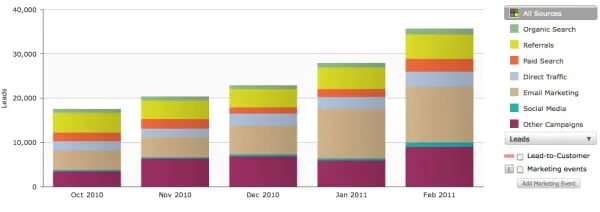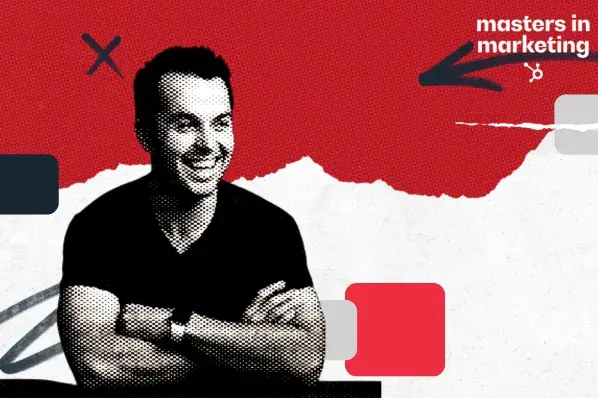Editor's Note: For complete information about HubSpot's Series D funding round, please check out the official press release.
Here is an insider’s take on the round of financing we just closed with Salesforce.com, Google, and Sequoia.
Why Raise More Money?
Before this round of financing, we had already raised three previous rounds, totaling $33 million of investment. That is a large amount of capital, and you can easily build a sustainable company with it. But, we want more than that, and there were three big reasons as to why we decided to raise another round.Three Reasons HubSpot Raised Another Funding Round
1. Only One Winner in Most Markets - In industries formed prior to the internet, oligopolies naturally formed where there is a market leader holding 20% marketshare, a 2nd place competitor having 18% or so, a 3rd having 15%, etc. In industries that have formed in the last 10 or so years, the opposite seems to be happening where the winner takes all (or at least 80% of the market cap in that given industry). A few examples include Amazon, VMWare, Zappos, Salesforce.com, Google, and even Groupon. We don’t feel like we are in their league yet, but we feel like we are out front in an important new industry and want to hit the gas and try to get into their league. It’s a go big or go home world we live in.2. The Perfect Investors - We are thrilled with our three new investors. Dharmesh and I have been studying Salesforce.com since we were in school together 6 years ago at MIT when HubSpot was just a twinkle in our eyes. We so admire Salesforce.com, that when we moved into our new office last year, we named one of our conference rooms “Benioff” after its founder. The same goes for Google – we consume as much information as we can about the way Google builds products, innovates around culture, etc. and we often emulate them. Like Benioff, we have a conference room named “Brin” and another one named “Page.” Sequoia is the top dog in the venture world and although we don’t have a conference room named for anyone over there, we’ve admired them from afar for a long time. I’m humbled to have these three firms, whom we so respect, take an ownership stake in HubSpot. Our existing investors, General Catalyst, Matrix, and Scale have been awesome. In order to make this round work, our existing investors had to be very flexible and go way out of their way to make this happen – a heartfelt thanks. In particular, thanks goes out to Larry Bohn (GC) and David Skok (Matrix) – these guys made early bets on us and have been immensely helpful every step of the way. There’s A LOT more hard work ahead of us and I’m sure glad these guys are on our team.
3. Funding Our Ambitious Vision - So, what are we going to do with all that cash? Well, we are not going to sit on it – we are going to invest it. As opposed to most late stage venture rounds where most of it is spent on sales and marketing, our plan is to invest much of it in R&D (and maybe some technology acquisitions) to further delight our customers and count on them to spread the word. We feel like this is the right approach in today’s transparent world. On the application side, we will make it faster, richer, and better. We will also open the entire product up into a platform by providing a clean, simple API. HubSpot is basically one big mash-up application that pulls information in from your website, Google, Twitter, Facebook, LinkedIn, your CRM system, etc. We want to allow other companies to integrate into HubSpot and extend it in new, useful ways.
How Did We Get Here?

We have made plenty of mistakes since starting the company, but we did a few things right from the start which made all the difference. 1. Marketing Transformation - HubSpot was built around two simple observations. First, that the traditional marketing playbook (cold calls, ads, etc) is broken as buyers are getting better and better at blocking these tactics out (spam protection, Caller ID, DVRs, etc). Second, that buyers have radically changed the way they shop, learn, work, and live – spending more and more time in search engines, blogs, and social media sites. Our vision from day one, has been to help companies transform the way they market to match the way humans actually shop, learn, and buy. Instead of interrupting them with emails, cold calls, ads, and other forms of outbound marketing, we help our customers pull them in from search engines, blogs, and social media sites and other forms of inbound marketing. We haven’t done everything right at HubSpot, but it feels like we got these founding principles right.
2. Easy and Integrated - We were inspired by the iPod & iTunes when we started the company. When the iPod came out, there were lots of other MP3 players on the market. Instead of making a better MP3 player, Apple focused on making the process of downloading and carrying music around much easier by integrating a simpler MP3 player (iPod), an application (iTunes), and the music itself. We took the same approach, rather than cobbling together an inbound marketing solution (blogging tools, SEO consultants, social media monitoring software, marketing automation tools, analytics, etc.), we built a system from the ground up that was focused on simplicity, so that mere mortals could make the transformation from old/outbound to new/inbound.
3. Eat our own dog-food - From day 1, we ate our own dog-food. Since the early days of HubSpot, we have lived in our own software. Initially, it was just me giving product feedback to Dharmesh, but now we have a largish marketing organization using it every day giving feedback to a largish R&D organization. We have also embraced the inbound marketing philosophy in the way we do marketing and that has paid off in spades – last month alone, we generated over 30,000 inbound leads.

If you have any questions about the round or any of our thinking, please feel free to leave a comment below and I’ll respond.
Topics:
Marketing Case Studies






![How to Turn a Case Study into a Customer Success Story [+ Tips from HubSpot Marketers]](https://53.fs1.hubspotusercontent-na1.net/hubfs/53/customer-success-story.jpg)



